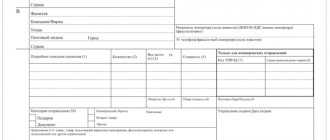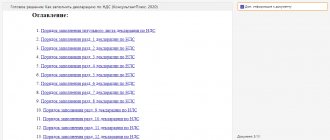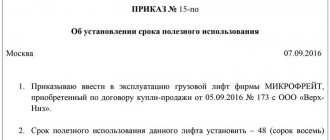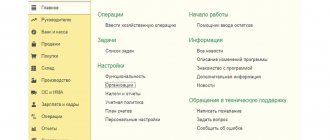What is VAT and how is it calculated
VAT is a value added tax. The relevant question is whether it is direct or indirect. The fee refers to indirect payments. The deduction is included in the price of almost all types of goods and services.
There are three rates in total for this deduction:
- The zero tariff is relevant for goods that are exported under the export procedure, as well as for some other types of services and products.
- A preferential rate of 10% is used for a number of goods that are considered socially significant - medicines, food products, products for children, etc.
- The basic rate of 20% applies in other cases if the goods do not fall under the category of non-taxable or taxed at a preferential rate.
Estimated rates also apply. For 20% they are 20/120, for 10% - 10/110. The amount of payment to the budget is calculated using indicators such as base and rate, the amount of compensation is subtracted from this, and arrears are added (if any).
Before paying the tax, you must fill out a declaration - the document is submitted electronically by the 25th day of the month following the reporting period (it is a quarter). If payments are not made on time, there is a risk of fines and penalties being charged to the payer. Their size depends on the amount of delay, the severity of the offense, etc.
What salary taxes are paid to the state?
Tax legislation requires monthly deductions upon receipt of wages. This process is monitored by the tax office. If an employer violates these rules for transferring funds, then liability arises, which includes a variety of penalties. An example is understatement of tax, which allows you to collect another 20% in the form of a fine in excess of the required amount.
Where do taxes go?
Important! According to the law, in particular labor and tax law, payment to the employee is made after taxes have been deducted, that is, the employee receives an amount that has already been calculated taking into account all the necessary deductions. The situation is the same if there are deductions, that is, a deduction is made from the entire amount, after which taxes are calculated from the remaining salary and the balance is paid.
Any violations lead to liability due to the fact that all deductions are necessary to ensure the region’s budget, as well as to maintain social funds. This leads to a tightening of the state's tax policy.
The main tax is personal income tax, which is calculated for wages in the amount of 13% for residents of the Russian Federation, highly qualified patent specialists or persons with citizenship of EAEU countries. For non-residents the tax is set at 30%.
What other contributions are paid?
Each organization and employer has an obligation to make insurance contributions to the Federal Tax Service.
Tariffing for this segment is established by Articles 427-429 of the Tax Code of the Russian Federation. The deduction is made from the total amount of payments to an employee or a person working under a civil law contract. On average, the total contribution is 30%. A number of companies have preferential terms, which allows you to make payments at a reduced rate. But in 2021, the number of such organizations has been reduced.
Another option for contributions is a deduction in the form of insurance funds, which can later be used in the event of an accident or work-related injuries, as well as occupational diseases.
An additional option is an increased payment for vehicles with excess power of 410 hp.
All payment options have a due date of the 15th of each month. If the deadlines are exceeded, penalties will be charged, which will need to be paid in addition to the amount initially established.
Article 427 of the Tax Code “Reduced rates of insurance premiums”
Read also: Temporary residence permit in 2021
Article 428 of the Tax Code “Additional tariffs of insurance contributions for certain categories of payers”
Article 429 of the Tax Code “Tariffs of insurance premiums for certain categories of payers for additional social security of flight crew members of civil aviation aircraft, as well as certain categories of employees of coal industry organizations”
Additional (indirect) taxes
An additional indirect tax is often referred to as VAT, which is a value added tax. It is paid by all companies that produce goods or provide any services. Most often, organizations include this tax in the cost of their products or services, that is, it turns out that paying this tax falls on consumers.
VAT rates:
- food products - 7%;
- non-food products - 9%;
- vodka and similar drinks - 50%;
- gasoline - 25%.
An additional indirect tax is the annual option of deductions for land, transport and property. In 2021, this category was supplemented with an environmental, tourism deduction, as well as a tax on self-employment (self-employed).
In general, it turns out that a citizen who works and receives a salary transfers almost half of his income to the state in the form of various deductions and payments. The state includes all funds received in a special budget, on the basis of which a number of programs are implemented, including social ones.
Tax deductions in the Russian Federation
Federal taxes and fees
In total, there are three main types of taxes to the budget - federal, regional and local. Value added tax is considered a federal contribution. But there are other payments that are paid at this level.
These include personal income tax - this is one of the main types of direct taxes. It is calculated as a percentage of the amount of income of individuals. Payers of personal income tax, according to existing laws, are residents of the Russian Federation, as well as non-residents receiving income in the Russian Federation.
What income is subject to personal income tax:
- From the sale of property that was owned for up to three years.
- Rental of premises.
- Income from sources outside the Russian Federation.
- Winnings and others.
The federal tax also includes a profit tax. This tax is direct, its size depends on the organization’s performance. The tax is charged on an indicator equal to the difference between income and expenses.
Payers are all Russian legal entities, as well as foreign legal entities with the status of residents of the Russian Federation, foreign companies whose place of management is recognized as the Russian Federation. This contribution is not required to be paid by persons working in special regimes, which include the unified agricultural tax, simplified tax system, etc.
Federal taxes include excise taxes. They can be paid by organizations and individual entrepreneurs, persons who are payers when moving goods through customs, and other persons in accordance with Chapter 22 of the Tax Code of the Russian Federation.
There is a list of excisable goods reflected in the legislation. Such goods, for example, include alcohol and products containing it, tobacco, cars and motorcycles, fuel, motor oils, gasoline, some medicines, veterinary drugs, etc. The amount is calculated as the product of the excise tax rate and the tax base.
The federal tax is the mining tax. Payers are organizations and individual entrepreneurs. The object of taxation is minerals mined within the Russian Federation, as well as outside its borders.
Water tax is paid by companies and individual entrepreneurs who use water bodies. The object of taxation is the use of water for hydropower and wood rafting. Individuals may also pay a fee on income from hydrocarbon production.
Division of taxes into federal, regional and local
The assignment of a particular tax to a certain level is established in the Tax Code. Article 13 lists federal taxes and fees:
- VAT;
- excise taxes;
- personal income tax;
- corporate income tax;
- MET;
- water tax;
- fees for the use of objects of the animal world and for the use of objects of aquatic biological resources.
In accordance with Article 14 of the Tax Code of the Russian Federation, regional taxes include:
- corporate property tax;
- gambling tax;
- transport tax.
Local taxes are discussed in Article 15 of the Tax Code of the Russian Federation. These include:
- land tax;
- property tax for individuals;
- trade fee.
Note! Among the listed taxes, special tax systems are not mentioned - simplified tax system, UTII, unified agricultural tax, PSN . What level of the tax system do they belong to? Paragraph 7 of Article 12 of the Tax Code of the Russian Federation states that the Code may establish special tax regimes providing for the payment of federal taxes not mentioned in Article 13. From this formulation it follows that all special regimes relate to the federal level .
Regional taxes
These fees include payments on property. This fee is calculated by organizations that have property recognized as an object of taxation. The base for this fee is established as the average annual price of the property.
Another tax is on the gambling business. The gambling business is an activity aimed at generating income for organizations in the form of winnings, fees for games and bets. The payer is the organization that carries out work in this area. The objects of taxation will be slot machines, tables, betting points, etc.
The third regional tax is on transport. Payers are the persons on whom the vehicle that is the subject of taxation is registered. Such means include motorcycles, cars, airplanes, helicopters, etc., with some exceptions prescribed by law.
Payment procedure for legal entities and individuals
Transport tax (advance and final payments) is paid at the actual location of the vehicle. For aircraft, river and sea transport, the location is the port to which they are registered or the place of state registration (if this is not the case, the owner’s residential address). For other types - the place of state registration or residence of the owner.
If during the reporting period the vehicle was deregistered, then special coefficients are taken into account when paying the tax. They are calculated based on entire months of transport use and the number of calendar months of the total tax period.
On January 1, 2021, a rule was introduced - the registration month is considered complete if the car is registered before the 15th day of the month (inclusive). For the month of deregistration, the rule is different - the month is considered full if the vehicle was deregistered after the 15th.
- Payment of tax by individuals is made after notification received by mail from the tax authorities. Tax authorities themselves will calculate the amount of tax based on information about the state registration of the vehicle. In 2021, the tax must be paid no later than December 1. A notice of tax collections can be sent in the prescribed form within a period not exceeding 3 tax periods that preceded the year it was sent.
- Legal organizations themselves generate tax reporting and the amount of advance payments, which are paid no later than the end of the month following the tax period (the first 3 quarters of the year).
Final payment of taxes is allowed no later than the deadline for filing returns (in 2021, this deadline ended on February 1). Regional authorities may set their own reporting deadlines; local legislation should be consulted on this issue.
Advance tax payments include increasing coefficients that apply to cars if their price exceeds 3 million rubles. The official website of the Federal Tax Service of Russia publishes a list of such cars every new year, no later than March 1.
Nowadays, increasing coefficients are taken into account both when paying taxes for the general period and when transferring advance payments.
What is the difference between taxes
What taxes are classified as federal, regional and local are specified in the legislation. Federal types of fees are reflected in the Tax Code; changes in payment details are made by tax authorities.
Regional fees are paid to the regional budget and apply to the constituent entities of the Russian Federation. Regional authorities may make changes to the rates of these taxes. The difference between the fees is that federal fees are paid to the federal budget, and regional payments are made to the regional budget.
Where and for what do taxes go in the state: distribution of funds
Each tax option has its own distribution. For example, personal income tax, calculated from a citizen’s salary, goes to the regional budget in the form of 85% of the total collection amount. 15% is transferred to the local municipality, where distribution is made according to needs. According to the law, the last funds are used to maintain infrastructure, repair public facilities, as well as public order and safety.
Medical insurance, pension and social security funds collect funds in one place, after which they are distributed according to the necessary costs for the specified needs.
The federal budget is replenished through the full collection of VAT. All funds are distributed annually to a number of industries. Among them:
- police and government agencies of similar types;
- government apparatus;
- military and national defense;
- education and its programs;
- science and all research and development;
- similar industries that are important in the activities of the state.
Where do taxes go?
Taxation is necessary for the implementation of all government programs, including social ones. It turns out that the citizen artificially invests the given income in improving his life and the life of society.
The entire structure of the distribution of funds is carried out through the influx of money into the budget, from where deductions are made to each area according to the plan. An example of a plan is the state budget, which is project documentation adopted by the government as the main act determining economic development for the required period (usually a year). The project has several parts, in particular open and closed.
The open part considers expenses for various spheres of activity and life of society, that is, it is possible to conduct an analysis to improve or worsen the lives of citizens by changing the level of wages and social security.
Read also: Tuition tax refund
The closed part includes defense spending and everything related to security and military spending. Typically, the closed part exceeds the remaining costs that are budgeted.
Important! When expenses increase and budget revenues decrease, a state deficit of funds arises, that is, a public debt is formed. An example would be the worsening economic situation and the necessary increase in VAT to 20%. This point is associated with the need to fill the budget by increasing costs for various programs.
When a deficit occurs, federal subsidies to the regions are reduced and costs in the form of subsidies for repaying the national debt increase. It is this point, coupled with the fact that taxation of citizens is one of the main incomes, that leads to an increase in the tax base of deductions and a tightening of tax legislation, in particular in case of violations.
It is worth considering that budget distribution is carried out on the basis of planned economic indicators, including inflation, prices for various minerals, which are budget revenues, and similar options.
Here's how that money will be distributed in 2021
All contributions received from the taxpayer must be included in the budget. An example would be work in Moscow and the corresponding deductions.
The official monthly salary is 30,000 rubles. There are no tax deductions; for this reason, a citizen will receive 26,100 rubles in hand, and for the year the employer will transfer 46,800 rubles to the budget. Accordingly, a table can be generated based on one taxpayer.
| Sphere | Example | Single annual deductions from one payer and distribution | Total required budget for the specified area, million |
| Transport | Repair work and replacement of escalators, creation of a route network | 8136.9 | 288 473.5 |
| Social | Various social programs, as well as additional assistance | 7805.3 | 276 717.1 |
| Educational | Art exhibitions, graduations, Olympics | 7746.9 | 274 647.1 |
| Housing and communal services | Additional overhaul, repair and renewal of communications, road cleaning, including snow removal | 6705.3 | 237 718 |
| Medical | Carrying out free examinations, vaccinations and improving free emergency care | 5143.5 | 182 349.8 |
| Economic and agricultural | Fairs, support for farms and enterprises | 5089 | 180 416.4 |
| Work of government and officials | Salaries and insurance of the Moscow state apparatus | 2693.8 | 95 503.1 |
| Cultural | Carrying out cultural events and supporting museums, theaters, libraries | 1321.6 | 46 854.3 |
| Sports | Holding competitions and mass sporting events | 834.9 | 29 600.1 |
| Ministry of Emergency Situations, police and similar structures | Fighting emergencies, fires and other incidents | 581 | 20 596.5 |
| mass media | Creation of regional broadcast channels | 328.8 | 11 658.3 |
| Ecological | Creation of metal collection points and holding mass landscaping events | 210.2 | 7 451.3 |
| Defense | Polygon content | 26.3 | 933 |
| Subsidized | Providing the necessary funds to local budgets | 21.8 | 774.4 |
Another area is the issuance of money to the federal budget from the region, that is, 154.5 rubles (total amount of 5476.6 million) are transferred to the federal authorities.
Documents and reporting for VAT payment
Taxpayers have the obligation to send the declaration to the place of registration. The deadline for submitting documentation is no later than the 25th day of the month following the expired period.
If a document is missing or provided at a later date, a fine is provided in accordance with Article 119 of the Tax Code of the Russian Federation. The document is filled out in rubles, kopecks are rounded up to the whole ruble or discarded. The title page and 1 section are indicated by all payers. The remaining sections are filled in according to the operations performed.







